Nahua PrayerThe censer was ritually activated by placing copal, a pine resin incense, under its base. The perfumed smoke then passed up through the chamber of the body and billowed out A recreation of the temple and effigy as it may have originally looked. Animation by Sam Koren and Domingo Monet. These priests went back and forth to the idol constantly, offering
it incense, and every time the incense was burned, each raised his
arm as high as he could. This ceremony was in honor of the god and
of the sun who were asked that all these prayers and pleas rise to
heaven just as the smoke rose.
Contemporary Rituals (read more...)
|





